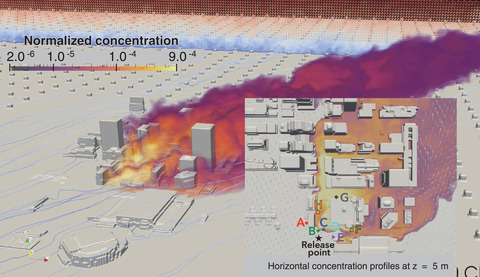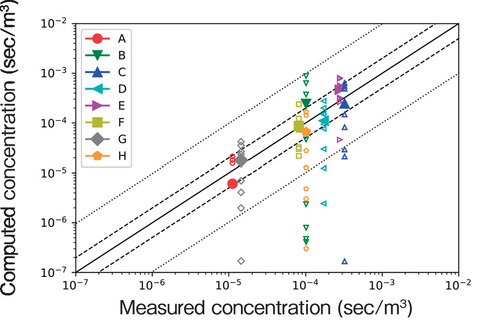
Fig.9-2 Visualization of buildings and concentration

Fig.9-3 Mean concentration (scatter plots)
The environmental dynamics of radioactive substances is accurately predicted based on detailed simulations of local airflow and plume dispersion to ensure nuclear security. Further, these kinds of flow simulations in urban areas are important tools when designing smart cities. The presence of tall buildings and complex structures makes airflows turbulent, necessitating large-scale computational fluid dynamics (CFD) simulations to clarify airflow details. However, the computational cost can become extremely large when trying to understand detailed wind dynamics, making it difficult to achieve the real-time or faster-than-real-time simulations required in emergencies, such as accidental releases of radioactive substances.
Realizing real-time (or faster) calculations requires two problems to be addressed: higher computational speeds and greater accuracy. First, real-time high-resolution simulations several tens of times faster than existing CFD methods are required. Second, in conventional simulations, experimental and simulated results often differ by a factor of five; environmental assessments require this difference to be reduced to a factor of two.
We developed two technological solutions to address these problems, the first of which involved a speed-up technology to realize a real-time multiscale simulation. Here, the different scales of urban wind flow were focused on, and a CFD analysis code, CityLBM, was developed based on the adaptive mesh refinement (AMR) method. Since fine computational grids are arranged only around buildings where the flow becomes turbulent, the number of computational grids (i.e., the computational cost) was reduced by a factor of 10 from the original method that did not employ the AMR method. Additionally, optimizing CFD schemes for the graphics processing units (GPUs) further reduced the computational time by a factor of 10, resulting in a final system approximately 100 times faster than other state-of-the-art methods, enabling faster-than-real-time simulations.
In the second developed solution, a probabilistic evaluation method was employed to improve accuracy of simulations for turbulent plume dispersion. In high-resolution simulations, turbulence causes large fluctuations in the time series of measurement instruments, leading to large uncertainty. Such uncertainty was reduced by a probabilistic evaluation based on ensemble calculations of multiple cases with slightly different initial values.
The CityLBM was validated against the field experiments performed during the JU2003* campaign conducted in the city center of Oklahoma City, as shown in Fig.9-2. Although the concentrations for each ensemble case (white symbols) were widely dispersed with the observed concentrations (black lines), the mean ensemble values (fill-in symbols) achieved the standard accuracy for environmental assessment in more than 70% of all observations (8 observation points × 3 time periods), as shown in Fig.9-3. These technological innovations thus allowed a real-time ensemble calculation that reduced the difference between simulated and experimental results to within a factor of two.
This research was supported in part by the Japan Society for the Promotion of Science (JSPS) KAKENHI Grants-in-Aid for Scientific Research (C) (No.JP19K11992, JP17K06570), (B) (No.JP17H03493) and the Ministry of Education, and the Joint Usage/Research Center for Interdisciplinary Large-scale Information Infrastructures in Japan (Project ID: jh200050-NAH).
(Naoyuki Onodera)
* Leach, M. J., Final Report for the Joint Urban 2003 Atmospheric Dispersion Study in Oklahoma City: Lawrence Livermore National Laboratory Participation, UCRL-TR-216437, 2005, 94p.
<Previous: 9 Computational Science and E-Systems Research | Next: 9-2>